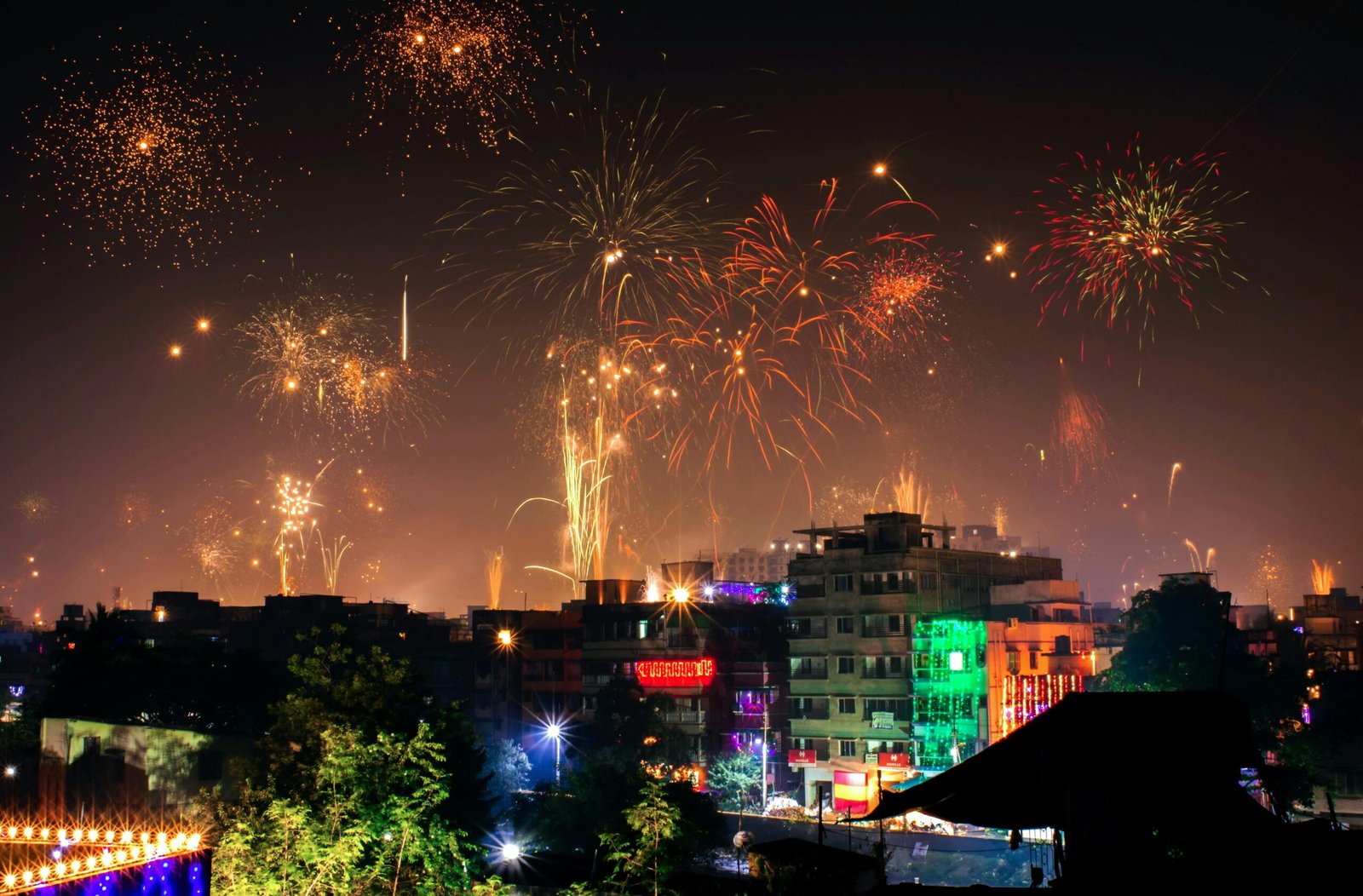Diwali, also known as the Festival of Lights, is one of the most celebrated and cherished festivals in India and around the world. This grand festival is marked by its vibrant traditions, splendid fireworks, and a spirit of joy and unity that brings families and communities together. Rooted in cultural and spiritual significance, Diwali is celebrated by millions of Hindus, Sikhs, Jains, and Buddhists with devotion and enthusiasm. In this guide, we’ll take you through every aspect of Diwali, from its origins and legends to its customs, foods, and eco-friendly celebrations.
What is Diwali?
Diwali, derived from the Sanskrit word “Deepavali” meaning “row of lights,” symbolizes the triumph of light over darkness and good over evil. This ancient festival has been celebrated for thousands of years and holds diverse meanings across cultures, yet it always represents hope, renewal, and the power of positivity. Diwali signifies new beginnings, prosperity, and a commitment to righteousness.
Significance of Diwali
Diwali’s significance varies depending on the cultural or religious background of those who celebrate it. For Hindus, it marks the return of Lord Rama to his kingdom of Ayodhya after a 14-year exile, symbolizing the victory of good over evil. In Jainism, Diwali celebrates Lord Mahavira’s attainment of nirvana. Sikhs commemorate the release of Guru Hargobind from imprisonment, while Buddhists, particularly those in Nepal, also observe Diwali with unique traditions.
When is Diwali Celebrated?
The date of Diwali changes every year, as it is based on the Hindu lunar calendar. The festival generally occurs between October and November, on the new moon day (Amavasya) of the Kartika month. Diwali spans over five days, with each day holding its own customs and significance. These days are known as Dhanteras, Naraka Chaturdashi, Lakshmi Puja, Govardhan Puja, and Bhai Dooj.
Legends Behind Diwali
Diwali is rich with fascinating legends that vary across regions.
The Story of Lord Rama:
After defeating the demon king Ravana, Lord Rama returned to Ayodhya with his wife Sita and brother Lakshmana. To celebrate his return, the people of Ayodhya lit oil lamps, symbolizing the triumph of good over evil.
The Tale of Narakasura and Lord Krishna:
According to another legend, Lord Krishna defeated the demon Narakasura on this day, freeing the people from his tyranny.
Goddess Lakshmi and Wealth:
Diwali is also dedicated to Goddess Lakshmi, the deity of wealth and prosperity, who is believed to visit homes and bless devotees with abundance.
Each of these legends contributes to Diwali’s themes of victory, renewal, and divine blessings.
Preparations for Diwali
The excitement for Diwali begins weeks in advance, as families prepare their homes and lives for the joyous festival. Houses are thoroughly cleaned and decorated with vibrant rangolis, lights, and flowers. People buy new clothes, utensils, and decorations, believing that fresh purchases will bring prosperity.
Rituals and Customs of Diwali
The customs of Diwali vary across regions, but several traditions are universal:
Lighting Diyas:
Small oil lamps, or diyas, are placed around homes, symbolizing the eradication of ignorance and the welcoming of knowledge and truth.
Lakshmi Puja:
Families perform a special prayer dedicated to Goddess Lakshmi, inviting her blessings for prosperity in the coming year.
Fireworks:
Fireworks and sparklers light up the night sky, representing the joy of the festival. However, recent years have seen a shift toward eco-friendly celebrations due to pollution concerns.
Traditional Diwali Foods
Diwali is synonymous with delicious sweets and savory foods. Every region has its special treats:
Sweets: Laddoos, barfis, jalebi, and gulab jamun are popular sweets enjoyed during the festival.
Savory Snacks: Dishes like samosas, kachoris, and chaklis are also prepared and shared with family and friends.
Regional Delicacies:
Each part of India has its unique food traditions, from Maharashtra’s karanji to South India’s murukku.
Diwali Decorations and Rangoli Designs
Colorful decorations and intricate rangoli designs are essential parts of Diwali. Rangolis are traditional floor patterns made with colored powders, rice, and flower petals, welcoming positivity and good fortune. Many also decorate with marigold flowers and vibrant garlands to add a festive touch.
Gifting During Diwali
Gift-giving is a beloved tradition during Diwali. Families and friends exchange sweets, jewelry, clothing, and even household items. Modern gifts include personalized items, electronic gadgets, and eco-friendly products, reflecting the evolving trends of the festival.
Diwali and Family Gatherings
One of the most cherished aspects of this is, its ability to bring families together. Relatives visit each other’s homes, share meals, and enjoy each other’s company. This unity is at the heart of Diwali, creating memories that last a lifetime.
Environmental Impact of Diwali Celebrations
While on this festival its a time of joy, its environmental impact, particularly from fireworks, has been a growing concern. Fireworks release pollutants that contribute to air and noise pollution, affecting health and the environment. In recent years, eco-friendly celebrations have gained popularity, with people choosing LED lights, paper decorations, and organic colors for rangoli.
Diwali Across the Globe
Diwali’s spirit extends far beyond India, with celebrations in countries like Nepal, Sri Lanka, Singapore, Malaysia, the United Kingdom, and the United States. Each region brings its cultural spin to this festival, blending traditional customs with local influences.
Safety Tips for Diwali
To celebrate safely:
Firecracker Safety: If using fireworks, always handle them with care, keeping a safe distance.
Candle and Diya Safety: Place candles and diyas on stable surfaces away from flammable materials.
First Aid Kit: Keep a first aid kit handy in case of minor injuries or burns.
Conclusion
This festival is a celebration of hope, joy, and the triumph of good over evil. With its rich cultural traditions, mouth-watering foods, and deep-rooted significance, it’s no wonder this festival has stood the test of time. Whether you’re lighting diyas, enjoying sweets, or simply spending time with loved ones, This festival reminds us all of the power of light and positivity.
FAQs
Why this festival celebrated?
Thsi Festival is celebrated to honor the victory of light over darkness, good over evil, and to invite prosperity and joy.
How long does this festival last?
It is typically celebrated over five days, each with unique traditions and significance.
What are the main symbols?
Diyas (oil lamps), rangolis, and fireworks are key symbols representing light, creativity, and joy.
Are there eco-friendly ways to celebrate?
Yes, opting for LED lights, biodegradable decorations, and avoiding fireworks are all eco-friendly ways to enjoy the festival.
How do different religions interpret?
Hindus, Sikhs, Jains, and Buddhists each have their unique traditions and beliefs related to this festival, yet all celebrate it as a festival of hope and positivity.
















